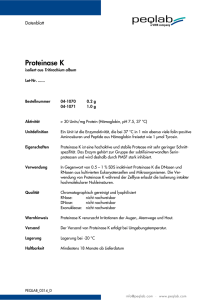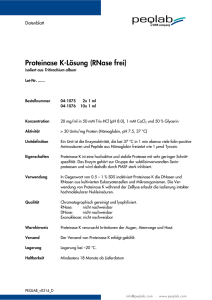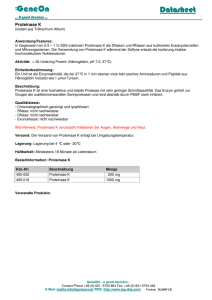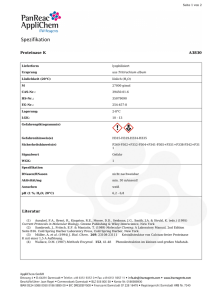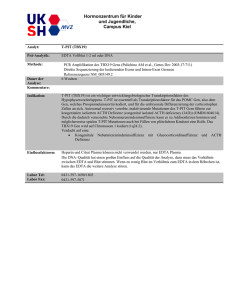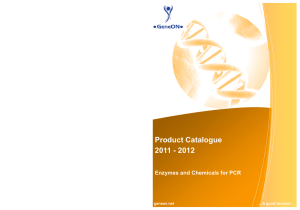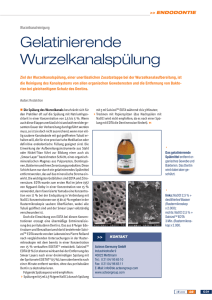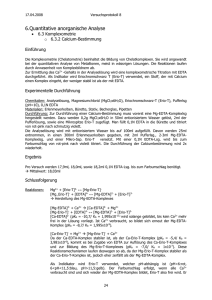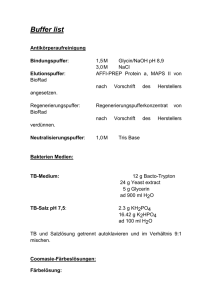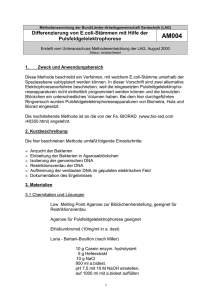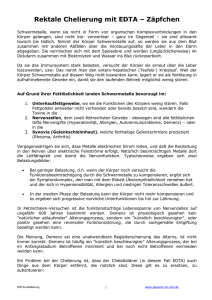Proteinase K - Genaxxon bioscience
Werbung
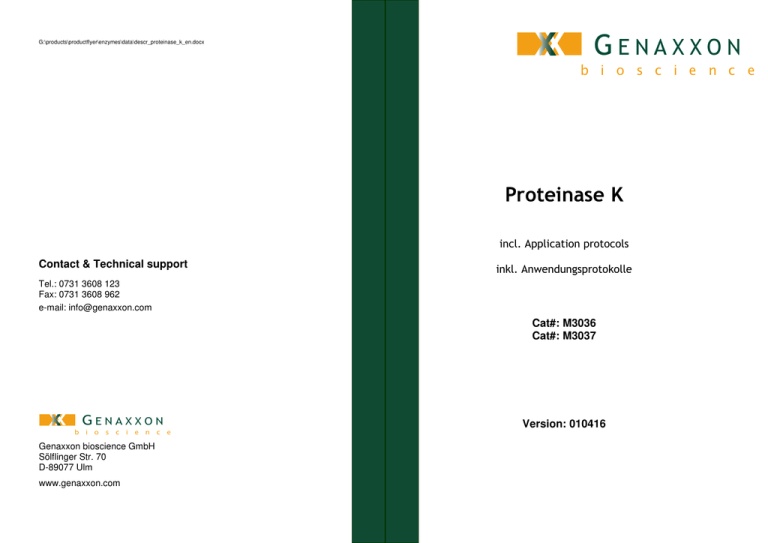
G:\products\productflyer\enzymes\data\descr_proteinase_k_en.docx X GENAXXON b i o s c i e n c e Proteinase K incl. Application protocols Contact & Technical support inkl. Anwendungsprotokolle Tel.: 0731 3608 123 Fax: 0731 3608 962 e-mail: [email protected] Cat#: M3036 Cat#: M3037 X GENAXXON b i o s c i e n Genaxxon bioscience GmbH Sölflinger Str. 70 D-89077 Ulm www.genaxxon.com c e Version: 010416 X GENAXXON b Description: Proteinase K is a non-specific serine protease having a very high specific activity. It has been used for isolation of mRNA, high molecular weight DNA and to inactivate other enzymatic activities. Proteinase K is active with or without the presence of SDS and EDTA. Source: Tritirachium album. Specific activity: >30 units/mg Form: Lyophilised powder (M3036) / frozen solution of 20mg/mL (M3037) Unit definition: One unit is defined as the amount of enzyme that liberates Folin-positive amino acids and peptides, corresponding to 1 pmol tyrosine under assay conditions in 1 minute using haemoglobin as substrate (1). Stability and storage: Proteinase K is stable at RT for short periods of time. For long term storage, we recommend -20°C. Preparation of Proteinase K solution: The standard concentration of a Proteinase K solution is 20mg/mL. For preparing this solution 20mg of Proteinase K is dissolved in 1mL pure (demineralised, DNAse and proteinase-free water). The solution is stable at -20°C for 2 years, but can also be stored at +2°C to +8°C°C for several months. QUALITY CONTROL 16-hour incubation: a 50µL reaction solution containing 1µg of lambda-DNA and 1.8 units enzyme incubated for 16 hours at 37°C resulted in the same DNA band pattern after gel electrophoresis as compared to the pattern produced without enzyme. Exonuclease activity: Incubation of 6 units of the enzyme for 4 hours at 37°C in 50µL assay buffer with 1g sonicated 3H DNA (3 x 10(5) cpm/µg) released less than 0.2% of radioactivity. Endonuclease activity: Incubation of 1.8 units of enzyme with 1µg PhiX174 RFI DNA in 50µL assay buffer for 4 hours at 37°C gave less than 1.5% conversion of RFI. RNAse contamination: Incubation of 6 units of enzyme with 1 µg MS2 RNA in 50µL assay buffer for 4 hours at 37°C resulted in the same RNA band pattern after gel electrophoresis as compared to the pattern produced without the enzyme. (1) Anson M.M (1939) J. Gen. Physiol., 22, 79. i o s c i e n c e Proteinase K is used for the destruction of proteins in cell lysates (tissue, cell culture cells) and for the release of nucleic acids, since it very inactivates DNases and RNases very effectively. Following some application examples: Application Protocols: • Isolation of genomic DNA from mammal cells (3h, 50°C) 10mM Tris/HCl (pH8.0), 100mM EDTA (pH8.0), 50mM NaCl, 0.5%SDS, 20µg/mL DNase free RNase, 100µg/mL proteinase K. • Isolation of genomic DNA from mice tails (overnight, 55°C) 20mM Tris/HCl (pH8.0), 5mM EDTA (pH8.0), 400mM NaCl, 1% SDS, 400µg/mL proteinase K. • Rapid isolation of genomic DNA as a PCR-template from cell cultures (1h, 37 °C) 67mM Tris/HCl (pH8.8), 16.6mM ammonium sulfate, 5mM β-mercaptoethanol, 6.7mM MgCl2, 6.7µM EDTA (pH8.0), 1.7µM SDS, 50µg/mL proteinase K. • Preparation of DNA for PFGE, lysis in agarose block (approx. 20h, 50°C). 100mM EDTA (pH8.0), 1 mM Tris/HCl (pH7.6), 20mM NaCl, 1% sarcosyl, 100µg/mL proteinase K • Purification of mRNA prior to cDNA synthesis (often leads to an increase in cDNA yield) (1-2h, 37°C) 100mM Tris/HCl (pH7.5), 10mM EDTA (pH8.0), 50mM NaCl, 0.1% SDS, 5µg/mL proteinase K. Proteinase K (Deutsche Beschreibung) Lyophilisiert (>30 U/mg) Isoliert aus Tritirachium album Proteinase K gehört zur Familie der Subtilisin-ähnlichen Serinproteasen mit starker proteolytischer Aktivität. Die Proteinase wird von Kulturen des Schimmelpilzes Tritirachium album sekretiert, wobei das ‚K‘ im Namen den Verdau von Keratin zur Deckung des Kohlen- und Stickstoffhaushaltes des Pilzes anzeigt. Proteinase K ist ein recht unspezifisches Enzym. Sie besitzt endo- und exoproteolytische Aktivität. Aktiviert durch Calcium (1-5mM) verdaut Proteinase K Proteine bevorzugt hinter (C-terminal) hydrophoben Aminosäuren (aliphatische, aromatische und andere hydrophobe Aminosäuren). Proteine werden komplett verdaut, wenn die Inkubationszeit lang genug ist und die Protease-Konzentration hoch ist. Das Enzym besitzt zwei Bindungsstellen für Ca2+ Ionen, die zwar nicht in die Katalyse eingreifen, aber zur strukturellen Stabilität des Proteins beitragen. Werden die Calciumionen entfernt sinkt die Stabilität des Enzyms, auch wenn die proteolytische Aktivität erhalten bleibt. Die Beseitigung der Ca2+-Ionen reduziert die katalytische Aktivität der Proteinase K um 80%. Die verbleibende Aktivität reicht aber aus um Proteine abzubauen, die üblicherweise Nukleinsäurepräparationen verunreinigen. Deshalb wird der Verdau mit Proteinase K für die Nukleinsäurereinigung gewöhnlich in Gegenwart von EDTA durchgeführt (Hemmung Magnesium-abhängiger Enzyme). • Purification of plasmid-DNA prior to in vitro transcription (1h, 37°C) Plasmid-DNA + 21mM Tris/HCl (pH8.0), 5mM EDTA (pH8.0), 50mM NaCl, 0.5% SDS, 100µg/mL proteinase K. Ist die Anwesenheit von Ca2+ notwendig, wird Ca2+ bis zu 1mM zugegeben und später mit EGTA beseitigt (pH8,0, Endkonz. 2mM). Das pH-Optimum liegt bei 8, das Enzym ist aber in einem weiten pH-Bereich aktiv (pH4,3 - 12). Eine Erhöhung der Reaktionstemperatur von 37°C auf 50 - 60°C kann die Aktivität mehrfach erhöhen, ebenfalls eine Zugabe von 0,5 1% SDS. Temperaturen über 65°C, Trichloressigsäure oder die Serinprotease-Inhibitoren AEBSF, PMSF oder DFP hemmen die Aktivität. Proteinase K wird nicht durch EDTA, Harnstoff (1 - 4M), SDS, Citrat, Iodessigsäure oder durch andere Serinprotease-Inhibitoren wie TLCK und TPCK gehemmt. • RNase inactivation in ribonuclease-protection-assays (30 min, 37°C) 30µL RNA/RNA-hybridisation mix + 300µL RNase digestion mix + 0.6% SDS, 300µg/mL proteinase K. Proteinase K kann durch Temperaturerhöhung auf 95°C gehemmt werden. Es ist darauf zu achten, dass die Inaktivierungstemperatur nicht unter 95°C liegt und die Dauer 10 Minuten unterschreitet. • Inactivation of DNase in transcription-run-on-assays (30 min, 42°C) Suspension of nuclei in 36mM Tris/HCl (pH7.4), 17mM MgCl2, 0.7mM CaCl2, 170mM NaCl, 13mM EDTA (pH8.0), 0.5% SDS with DNase, 100µg/mL proteinase K. Product • Purification of PCR-reactions prior to cloning (overnight, 55°C) PCR-reaction + 10mM Tris/HCl (pH8.0), 5mM EDTA (pH8.0), 400mM NaCl, 1% SDS, 400µg/mL proteinase K. • Denaturation of alkaline phosphatase when cipping vector DNA (30 min, 56°C) 1 x dephosphorylation buffer + 0.5% SDS, 5mM EDTA (pH8.0), 100µg/mL proteinase K. Cat# Package size Proteinase K (from Tritirachium album) M3036.0100 100mg Proteinase K (from Tritirachium album) M3036.0200 200mg Proteinase K (from Tritirachium album) M3036.0500 500mg Proteinase K solution (20mg/mL) M3037.0001 1mL Proteinase K solution (20mg/mL) M3037.0005 5 x 1mL Proteinase K wird für den Abbau von Proteinen in Zelllysaten (Gewebe, Zellkulturzellen) und zur Freisetzung von Nukleinsäuren verwendet, da sie auch sehr effektiv DNasen und RNasen inaktiviert. Nachfolgend einige Anwendungsbeispiele: Anwendungen: • Isolation genomischer DNA aus Säugerzellen (3h, 50°C). 10mM Tris-Cl (pH8,0), 100 mM EDTA (pH8,0), 50 mM NaCl, 0,5% SDS, 20µg/mL DNAse freie RNAse, 100µg/mL Proteinase K. • Isolation genomischer DNA aus Mausschwänzen (über Nacht, 55°C) 20mM Tris-Cl (pH8,0), 5mM EDTA (pH8,0), 400mM NaCl, 1% SDS, 400µg/mL Proteinase K. • Schnelle Isolation von genomischer DNA als PCR-Template aus Zellkulturen (1h, 37°C) 67mM Tris/HCl (pH8,8), 16,6mM Ammoniumsulfat, 5mM -Mercaptoethanol, 6,7mM MgCl2, 6,7µM EDTA (pH8,0), 1,7µM SDS, 50µg/mL Proteinase K. • Präparation von DNA für die PFGE Lyse im Agaroseblock (ca. 20h, 50°C). 100mM EDTA (pH8,0), 10mM Tris/HCl (pH7,6), 20mM NaCl, 1% Sarcosyl, 100µg/mL Proteinase K. • Reinigung von mRNA vor der cDNA Synthese (führt oftmals zur Steigerung der cDNA Ausbeute) (1-2h, 37°C). 100mM Tris/HCl (pH7,5), 10mM EDTA (pH8,0), 50mM NaCl, 0,1% SDS, 5µg/mL Proteinase K. • Aufreinigung von PCR-Ansätzen vor der Klonierung (über Nacht, 55°C). PCR-Ansätze + 10mM Tris/HCl (pH8,0), 5mM EDTA (pH8,0), 400mM NaCl, 1% SDS, 400µg/mL Proteinase K. • Aufreinigung von Plasmid-DNA vor in vitro Transcription (1h, 37°C) Plasmid-DNA + 21mM Tris/HCl (pH8,0), 5mM EDTA (pH8,0), 50mM NaCl, 0,5% SDS, 100µg/mL Proteinase K • RNAse Inaktivierung im Ribonuklease-ProtectionAssay (30 min, 37°C) 30µL RNA/RNA-Hybridisierungsmix + 300µL RNAse-Verdau Mix + 0,6% SDS, 300µg/mL Proteinase K. • Inaktivierung der DNAse in Transkriptions-Run-OnAssays. (30 min, 42°C) Suspension der Zellkerne in 36mM Tris/HCl (pH7,4), 17mM MgCl2, 0,7mM CaCl2, 170mM NaCl, 13mM EDTA (pH8,0), 0,5% SDS mit DNAse, 100µg/mL Proteinase K. • Denaturierung der Alkalischen Phosphatase beim Cippen von Vektor DNA (30 min, 56°C) 1 x Dephosphorylierungspuffer + 0,5% SDS, 5mM EDTA (ph8,0), 100µg/mL Proteinase K. Proteinase K (English description) lyophilised (>30 U/mg) isolated from Tritirachium album Proteinase K belongs to the familiy of subtilisin-like serine proteases with very strong proteolytic activity.The enzyme is secreted from Tritirachium album cultures, whereus the “K” stands for the Kreatin (German for Creatine) the main source of carbon and nitrogen source of Tritirachium album. Proteinase K is a unspecific protease that shows endo- and exoproteolytic activity. Activated by calcium (1 - 5mM), the enzyme digests proteins preferentially after hydrophobic amino acids (aliphatic, aromatic and other hydrophobic amino acids). Proteins will be completely digested, if the incubation time is long and the protease concentration high enough. The enzyme has two binding sites for Ca2+ ions which do not really participate in the catalysis, but do contribute to the structural stability of the protein. Upon removal of the calcium ions, the stability of the enzyme is reduced, but the proteolytic activity remains. Proteinase K has two binding sites for Ca2+, which are located close to the active center, but are not directly involved in the catalytic mechanism. Removal of the Ca2+-ions reduces the catalytic activity of proteinase K by 80 %. The residual activity is sufficient to digest proteins, which usually contaminate nucleic acid preparations. Therefore, the digest with proteinase K for the purification of nucleic acids is performed in the presence of EDTA (inhibition of magnesium-dependent enzymes). If the presence of Ca2+ is required, Ca2+ is added up to a concentration of 1mM and is removed by the addition of EGTA (pH8.0; final conc. 2mM) later on. The pH-optimum is at pH8, but the enzyme is active over a wide pH-range (pH4.3 - 12). An elevation of the reaction temperature from 37°C to 50 - 60°C may increase the activity several times, like the addition of 0.5 - 1% SDS. Temperatures above 65°C, trichloroacetic acid or the serine protease-inhibitors AEBSF, PMSF or DFP will inhibit the activity. Proteinase K will not be inhibited by EDTA, urea (1 - 4M), SDS, citrate, iodoacetic acid or, by other serine protease inhibitors like TLCK and TPCK. Proteinase K can be inactivated by incubation at a temperature of 95°C. Make sure that inactivation temperature is not below 95°C and inactivation time not shorter than 10 minutes. Product Cat# Package size Proteinase K (from Tritirachium album) M3036.0100 100mg Proteinase K (from Tritirachium album) M3036.0200 200mg Proteinase K (from Tritirachium album) M3036.0500 500mg Proteinase K solution (20mg/mL) M3037.0001 1mL Proteinase K solution (20mg/mL) M3037.0005 5 x 1mL
